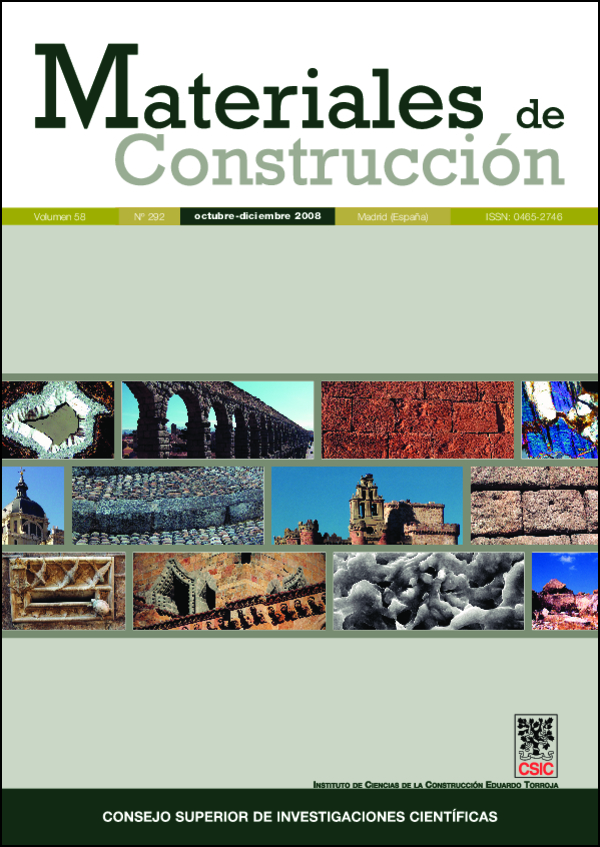Effect of paint on vapour resistivity in plaster
DOI:
https://doi.org/10.3989/mc.2008.35206Keywords:
gypsum, plaster, vapour permeability, paints, thermodynamic calculationsAbstract
The vapour resistivity of plaster coatings such as paint and their effectiveness as water repellents were studied in several types of plaster. To this end, painted, unpainted and pigmented specimens were tested. Experimental values were collected on diffusion and vapour permeability, or its inverse, water vapour resistivity.
The data obtained were very useful for evaluating moisture exchange between plaster and the surrounding air, both during initial drying and throughout the life of the material. They likewise served as a basis for ensuring the proper evacuation of water vapour in walls, and use of the capacity of the porous network in plaster products to regulate moisture content or serve as a water vapour barrier to avoid condensation.
Briefly, the research showed that pigments, water-based paints and silicon-based water repellents scantly raised vapour resistance. Plastic paints, enamels and lacquers, however, respectively induced five-, ten- and twenty-fold increases in vapour resistivity, on average.
Downloads
References
(1) Dupont, N.: “Absorption et reset d´humidité dans les enduits a base de plâtre”. Revue des Materiaux de Construction, nº 667 (1971) pp. 99-101.
(2) Atedy (Asociación Técnica y Empresarial del Yeso) Villanueva Domínguez, L. de y García Santos, A. Manual del yeso. pp. 63-66, Cie Dossat 2000. Madrid (2001).
(3) S.N.I.P. (Syndicat Nacional des Industries du Plâtre). Le plâtre. pp. 323-325, Eyrolles. París (1982).
(4) NBE-CT 79 Norma Básica de la Edificación.- Condiciones Térmicas. Ministerio de Obras Públicas y Urbanismo. Madrid (1979).
(5) Queirolo Varela, E.: Yeso de proyección coloreado en masa, bajo el nombre de YESOLITE. Patente nº 10.186 del Uruguay, de 25 de mayo de (1971).
(6) Villanueva, L de, Lara, G., Vivanco, B., Pérez Ramos, F. J., E. M., Sánchez Gutiérrez, E. M.: “Incidencia de la pintura en la regulación de la humedad por el yeso. Efecto Queirolo” VII Jornada sobre aplicaciones arquitectónicas de materiales. Dep. Construcción. ETSAM. UPM. Madrid (2003).
(7) Departamento de Energía de los Estados Unidos “Retardadores de difusión de vapor y barreras de aire”.
(8) Vorkart, K.: Bauen mit Gips B.G.G. (Bundesverband der Gips und Gipsbauplattenindustrie). Darmstadt (1978).
(9) Eichler, E.: Patología de la construcción. pp. 386-387, Ed. Blume. Barcelona (1975).
(10) Neila, J y Bedoya, C.: Patología de los elementos constructivos. Las condensaciones. Tratado de Rehabilitación. Tomo 5. p. 34, Ed. Munilla-lería. Madrid (1999).
(11) Peradotto, A.: Gesso: salute e sicurezza. pp. 252-269, Tesis doctoral realizada en el Politécnico de Turín bajo la dirección del Dr. A. Negro. (1977).
Downloads
Published
How to Cite
Issue
Section
License
Copyright (c) 2008 Consejo Superior de Investigaciones Científicas (CSIC)

This work is licensed under a Creative Commons Attribution 4.0 International License.
© CSIC. Manuscripts published in both the print and online versions of this journal are the property of the Consejo Superior de Investigaciones Científicas, and quoting this source is a requirement for any partial or full reproduction.
All contents of this electronic edition, except where otherwise noted, are distributed under a Creative Commons Attribution 4.0 International (CC BY 4.0) licence. You may read the basic information and the legal text of the licence. The indication of the CC BY 4.0 licence must be expressly stated in this way when necessary.
Self-archiving in repositories, personal webpages or similar, of any version other than the final version of the work produced by the publisher, is not allowed.
















